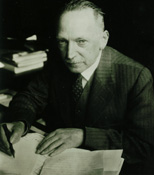Max Jakob Friedländer facts for kids
Max Jakob Friedländer (born July 5, 1867, in Berlin; died October 11, 1958, in Amsterdam) was an important German museum expert and art historian. He was especially good at studying early Dutch and Belgian paintings, known as Early Netherlandish painting, and art from the Northern Renaissance.
Max Friedländer started working at the Kupferstichkabinett Berlin in 1891. Later, in 1896, he became an assistant for paintings at the Kaiser Friedrich Museum. He became the deputy director of this museum in 1904 and then the director from 1924 to 1932. During this time, he wrote famous books like From Van Eyck to Bruegel and a 14-volume series called Early Netherlandish Painting.
Sadly, in 1933, he was forced to leave his job because he was Jewish. In 1939, he had to move to Amsterdam to escape danger. He was also given a special title called geheimrat (privy councillor) in Germany. He gave many artworks to museums and also helped people buy and sell art.
Friedländer also came up with the art style name Antwerp Mannerism. He gave names to many artists from that time whose real names were not known. These are called notnames. It's good to know that he was not related to another art historian named Walter Friedländer.
How He Studied Art
Max Friedländer studied art like a connoisseur. This means he focused on carefully looking at artworks and trusting his own feelings and knowledge about them. He didn't rely on big, complicated art theories.
He once explained his way of working:
Even if figuring out who made a piece of art isn't the most important thing, it's a great way to train your eye. When you try to find out who the artist is, you have to look very closely at the artwork. This helps you understand the art deeply. One single artwork, understood well, can teach you more than a general study of all art ever could.
Friedländer often focused on the German side of early Dutch and Belgian art. He helped create the term "Early Netherlandish art." He sometimes emphasized the German character of this art more than its connections to French-speaking areas or its local styles.
His Photo Collection
Throughout his life, Max Friedländer took many high-quality photos of artworks. He traveled a lot to do this. His personal collection has about 15,000 photos and copies of paintings from the 15th and 16th centuries. These paintings are from both the northern and southern Netherlands.
He often wrote notes with his photos. These notes included details like who owned the painting before, who he thought the artist was, how good the painting's condition was, and where it was located. Most of his work has been written down and put online in the RKDimages database. This database is part of the Dutch National Institute of Art History (RKD). It's a very important collection that art historians can use for free.
See also
 In Spanish: Max Friedländer para niños
In Spanish: Max Friedländer para niños


